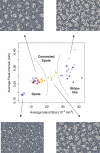Patterns of mesenchymal condensation in a multiscale, discrete stochastic model
- PMID: 17465675
- PMCID: PMC1857812
- DOI: 10.1371/journal.pcbi.0030076
Patterns of mesenchymal condensation in a multiscale, discrete stochastic model
Abstract
Cells of the embryonic vertebrate limb in high-density culture undergo chondrogenic pattern formation, which results in the production of regularly spaced "islands" of cartilage similar to the cartilage primordia of the developing limb skeleton. The first step in this process, in vitro and in vivo, is the generation of "cell condensations," in which the precartilage cells become more tightly packed at the sites at which cartilage will form. In this paper we describe a discrete, stochastic model for the behavior of limb bud precartilage mesenchymal cells in vitro. The model uses a biologically motivated reaction-diffusion process and cell-matrix adhesion (haptotaxis) as the bases of chondrogenic pattern formation, whereby the biochemically distinct condensing cells, as well as the size, number, and arrangement of the multicellular condensations, are generated in a self-organizing fashion. Improving on an earlier lattice-gas representation of the same process, it is multiscale (i.e., cell and molecular dynamics occur on distinct scales), and the cells are represented as spatially extended objects that can change their shape. The authors calibrate the model using experimental data and study sensitivity to changes in key parameters. The simulations have disclosed two distinct dynamic regimes for pattern self-organization involving transient or stationary inductive patterns of morphogens. The authors discuss these modes of pattern formation in relation to available experimental evidence for the in vitro system, as well as their implications for understanding limb skeletal patterning during embryonic development.
Conflict of interest statement
Figures







References
-
- Newman SA, Müller GB. Origination and innovation in the vertebrate limb skeleton: An epigenetic perspective. J Exp Zoolog B Mol Dev Evol. 2005;304:593–609. - PubMed
-
- Leonard CM, Fuld HM, Frenz DA, Downie SA, Massagué J, et al. Role of transforming growth factor-beta in chondrogenic pattern formation in the embryonic limb: Stimulation of mesenchymal condensation and fibronectin gene expression by exogenous TGF-β and evidence for endogenous TGF-β–like activity. Dev Biol. 1991;145:99–109. - PubMed
-
- Miura T, Shiota K. TGF β2 acts as an “activator” molecule in reaction–diffusion model and is involved in cell sorting phenomenon in mouse limb micromass culture. Dev Dyn. 2000;217:241–249. - PubMed
-
- Chimal-Monroy J, Rodriguez-Leon J, Montero JA, Gañan Y, Macias D, et al. Analysis of the molecular cascade responsible for mesodermal limb chondrogenesis: sox genes and BMP signaling. Dev Biol. 2003;257:292–301. - PubMed
-
- Downie SA, Newman SA. Different roles for fibronectin in the generation of fore and hind limb precartilage condensations. Dev Biol. 1995;172:519–530. - PubMed
Publication types
MeSH terms
LinkOut - more resources
Full Text Sources

